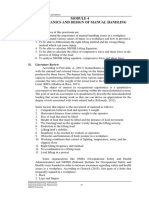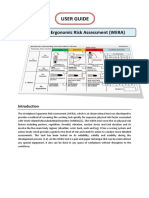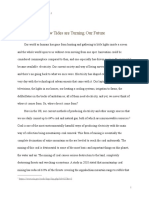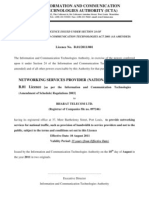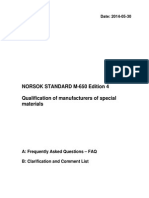100%(1)100% found this document useful (1 vote)
146 viewsNIOSH Lifting Equation
NIOSH Lifting Equation
Uploaded by
Rochelle AnneThe NIOSH Lifting Equation is a tool used by occupational health and safety professionals to assess manual material handling risks associated with lifting and lowering tasks. It considers job task variables to determine safe lifting guidelines and provides a Recommended Weight Limit and Lifting Index to define a safe weight and estimate risk of musculoskeletal disorders.
The Rapid Entire Body Assessment (REBA) tool uses a systematic process to evaluate whole body musculoskeletal and ergonomic design risks associated with job tasks. It assigns scores to different body regions and compiles them to generate a single risk level score.
The Rapid Upper Limb Assessment (RULA) similarly assesses biomechanical and postural load requirements on the neck, trunk and upper extrem
Copyright:
© All Rights Reserved
Available Formats
Download as DOCX, PDF, TXT or read online from Scribd
NIOSH Lifting Equation
NIOSH Lifting Equation
Uploaded by
Rochelle Anne100%(1)100% found this document useful (1 vote)
146 views2 pagesThe NIOSH Lifting Equation is a tool used by occupational health and safety professionals to assess manual material handling risks associated with lifting and lowering tasks. It considers job task variables to determine safe lifting guidelines and provides a Recommended Weight Limit and Lifting Index to define a safe weight and estimate risk of musculoskeletal disorders.
The Rapid Entire Body Assessment (REBA) tool uses a systematic process to evaluate whole body musculoskeletal and ergonomic design risks associated with job tasks. It assigns scores to different body regions and compiles them to generate a single risk level score.
The Rapid Upper Limb Assessment (RULA) similarly assesses biomechanical and postural load requirements on the neck, trunk and upper extrem
Original Description:
Niosh ctto
Copyright
© © All Rights Reserved
Available Formats
DOCX, PDF, TXT or read online from Scribd
Share this document
Did you find this document useful?
Is this content inappropriate?
The NIOSH Lifting Equation is a tool used by occupational health and safety professionals to assess manual material handling risks associated with lifting and lowering tasks. It considers job task variables to determine safe lifting guidelines and provides a Recommended Weight Limit and Lifting Index to define a safe weight and estimate risk of musculoskeletal disorders.
The Rapid Entire Body Assessment (REBA) tool uses a systematic process to evaluate whole body musculoskeletal and ergonomic design risks associated with job tasks. It assigns scores to different body regions and compiles them to generate a single risk level score.
The Rapid Upper Limb Assessment (RULA) similarly assesses biomechanical and postural load requirements on the neck, trunk and upper extrem
Copyright:
© All Rights Reserved
Available Formats
Download as DOCX, PDF, TXT or read online from Scribd
Download as docx, pdf, or txt
100%(1)100% found this document useful (1 vote)
146 views2 pagesNIOSH Lifting Equation
NIOSH Lifting Equation
Uploaded by
Rochelle AnneThe NIOSH Lifting Equation is a tool used by occupational health and safety professionals to assess manual material handling risks associated with lifting and lowering tasks. It considers job task variables to determine safe lifting guidelines and provides a Recommended Weight Limit and Lifting Index to define a safe weight and estimate risk of musculoskeletal disorders.
The Rapid Entire Body Assessment (REBA) tool uses a systematic process to evaluate whole body musculoskeletal and ergonomic design risks associated with job tasks. It assigns scores to different body regions and compiles them to generate a single risk level score.
The Rapid Upper Limb Assessment (RULA) similarly assesses biomechanical and postural load requirements on the neck, trunk and upper extrem
Copyright:
© All Rights Reserved
Available Formats
Download as DOCX, PDF, TXT or read online from Scribd
Download as docx, pdf, or txt
You are on page 1of 2
NIOSH Lifting Equation
The NIOSH Lifting Equation is a tool used by occupational health and
safety professionals to assess the manual material handling risks
associated with lifting and lowering tasks in the workplace. This
equation considers job task variables to determine safe lifting
practices and guidelines.
The primary product of the NIOSH lifting equation is the
Recommended Weight Limit (RWL), which defines the maximum
acceptable weight (load) that nearly all healthy employees could lift
over the course of an 8 hour shift without increasing the risk of
musculoskeletal disorders (MSD) to the lower back. In addition, a
Lifting Index (LI) is calculated to provide a relative estimate of the level
of physical stress and MSD risk associated with the manual lifting
tasks evaluated.
Rapid Entire Body Assessment (REBA)
This tool uses a systematic process to evaluate whole body postural
MSD and ergonomic design risks associated with job tasks. A single
page form is used to evaluate required body posture, forceful
exertions, type of movement or action, repetition, and coupling. A
score is assigned for each of the following body regions: wrists,
forearms, elbows, shoulders, neck, trunk, back, legs and knees. After
the data for each region is collected and scored, tables on the form
are then used to compile the risk factor variables, generating a single
score that represents the level of MSD risk.
Rapid Upper Limb Assessment (RULA)
This diagnostic tool assesses biomechanical and postural load
requirements of job tasks/demands on the neck, trunk and upper
extremities. A single page form is used to evaluate required body
posture, force, and repetition. Based on the evaluations, scores are
entered for each body region in section A for the arm and wrist, and
section B for the neck and trunk. After the data for each region is
collected and scored, tables on the form are then used to compile the
risk factor variables, generating a single score that represents the
level of MSD risk.
Washington State Ergonomic and MSD Risk Assessment Checklist
This tool is designed to evaluate ergonomic risks factors including
awkward postures, highly repetitive motions, high hand force,
repeated impacts, lifting, and hand-arm vibration. The Caution Zone
Checklist is used as a screening tool. If there are no positive findings
identified, the job is regarded to be safe; otherwise a moderate risk is
indicated and the job should be evaluated further using the Hazard
Zone Checklist. Positive findings with the Hazard Zone Checklist
indicate immediate actions should be taken to reduce the risk.
https://ergo-plus.com/ergonomic-assessment-tools/
You might also like
- Students EnquiryDocument19 pagesStudents EnquiryRaghav SinghNo ratings yet
- RULA A Step by Step Guidepertemuan (10 11)Document10 pagesRULA A Step by Step Guidepertemuan (10 11)Yirreh Narwastu AjiNo ratings yet
- Niosh - RulaDocument18 pagesNiosh - RulaDomingo Carrasco Guzmán100% (1)
- National For Occupational Safety and Health: NioshDocument6 pagesNational For Occupational Safety and Health: NioshSherina CapolaNo ratings yet
- Comparison Reba and QecDocument7 pagesComparison Reba and Qecm_myfrenNo ratings yet
- Biomechanics and Design of Manual HandlingDocument11 pagesBiomechanics and Design of Manual HandlingWisnu Agung SetiajiNo ratings yet
- 1-ERGO 1 PPT Fin Ergo ToolsDocument18 pages1-ERGO 1 PPT Fin Ergo Toolsleidurwin22No ratings yet
- REBA-Guide-v-5.0Document19 pagesREBA-Guide-v-5.0Azizah ArsyNo ratings yet
- REBA - Rapid Entire Body Assessment: ErgonomicsDocument15 pagesREBA - Rapid Entire Body Assessment: ErgonomicsJeay officialNo ratings yet
- Step by Step Guides V 1.2Document81 pagesStep by Step Guides V 1.2Nur IslamiNo ratings yet
- RULA Step by Step Guide1Document13 pagesRULA Step by Step Guide1pmontanherNo ratings yet
- WERA Tool User GuideDocument2 pagesWERA Tool User GuidetheleoneNo ratings yet
- Rapid Upper Limb Assessment (RULA) - 20221209Document11 pagesRapid Upper Limb Assessment (RULA) - 20221209Mário Silva100% (1)
- Introduction LAB 3 ISHDocument2 pagesIntroduction LAB 3 ISHArham SyamNo ratings yet
- REBA CalculationDocument19 pagesREBA CalculationAkarshaNo ratings yet
- Introduction Rosa RulaDocument1 pageIntroduction Rosa RulaUstaz EnjinNo ratings yet
- A Systematic Approach of Ergonomics Assessment Tool SelectionDocument11 pagesA Systematic Approach of Ergonomics Assessment Tool SelectionEPNo ratings yet
- RULA Mcatamney 1993 PDFDocument10 pagesRULA Mcatamney 1993 PDFFausto Corsino TorresNo ratings yet
- RULA - A Survey Method For The Investigation of Work-Related Upper Limb Disorders PDFDocument10 pagesRULA - A Survey Method For The Investigation of Work-Related Upper Limb Disorders PDFAchmad SyukronNo ratings yet
- RULA: A Survey Method For The - Irwestigation of World-Related Upper Limb DisordersDocument10 pagesRULA: A Survey Method For The - Irwestigation of World-Related Upper Limb DisordersSanty SanNo ratings yet
- Assessment of Repetitive Tasks of The Upper Limbs (The ART Tool)Document16 pagesAssessment of Repetitive Tasks of The Upper Limbs (The ART Tool)hildaNo ratings yet
- Lifting Equation For Manual LiftingDocument10 pagesLifting Equation For Manual LiftingShafiqul IslamNo ratings yet
- Ergonomic Tools ERBADocument9 pagesErgonomic Tools ERBASavannah YonitaNo ratings yet
- Step-by-Step GuidesDocument83 pagesStep-by-Step Guidesحنيف سجدNo ratings yet
- Sasikumar 2018Document35 pagesSasikumar 2018sanjid2516No ratings yet
- Rula 2Document19 pagesRula 2devil cryNo ratings yet
- REBA A Step by Step GuideDocument11 pagesREBA A Step by Step GuideRizky Erizka100% (1)
- Ergonomic Risk AssessmentDocument10 pagesErgonomic Risk AssessmentMaham batoolNo ratings yet
- QECDocument7 pagesQECUci Marlina PasaribuNo ratings yet
- Ergonomic 2Document45 pagesErgonomic 2Akhilesh Kumar SinghNo ratings yet
- Ergonomics Study On Human-Powered Vehicles: - IntroductionDocument6 pagesErgonomics Study On Human-Powered Vehicles: - IntroductionArun MohapatraNo ratings yet
- NIOSH Guide V 5.5Document23 pagesNIOSH Guide V 5.5Husain FarooqNo ratings yet
- IJTRD21911Document3 pagesIJTRD21911SubhadeepNo ratings yet
- Risk Assessment - Chapter 16Document30 pagesRisk Assessment - Chapter 16Sebastian iacopiNo ratings yet
- ErgonomicsDocument18 pagesErgonomicsTrebor SantosNo ratings yet
- Comparisions of Ergonomic Evaluation Tools (ALLA, RULA, REBA and OWAS) For Farm WorkDocument20 pagesComparisions of Ergonomic Evaluation Tools (ALLA, RULA, REBA and OWAS) For Farm WorkEsteban Varas RamírezNo ratings yet
- rANGKUMAN tHEORYDocument14 pagesrANGKUMAN tHEORYAhmad AtoNo ratings yet
- The Utah Lifting Index An Exploration of Low BackDocument9 pagesThe Utah Lifting Index An Exploration of Low BackKevin TorresNo ratings yet
- 3Document1 page3Bintang S. PanjaitanNo ratings yet
- Risk Analysis of Gari FryingDocument13 pagesRisk Analysis of Gari FryingSamuelShinaAyodeleNo ratings yet
- Ocra 1Document24 pagesOcra 1Maryko Awang HerdianNo ratings yet
- RULADocument4 pagesRULAMichael QuidorNo ratings yet
- Musculoskeletal Disorder (MSD) Risk Assessment ToolsDocument15 pagesMusculoskeletal Disorder (MSD) Risk Assessment ToolsJulio Alberto Pambabay SantacruzNo ratings yet
- CATIA V5 HUMAN Analysis IntroductionDocument27 pagesCATIA V5 HUMAN Analysis IntroductionJony M. TemnikarNo ratings yet
- Ergonomics Article Review by REBADocument11 pagesErgonomics Article Review by REBAtom agazhieNo ratings yet
- ErgonomicsDocument9 pagesErgonomicsMUHAMMAD FIRAS BIN MOHD FAIZ MoeNo ratings yet
- 1 s2.0 S2214785321013821 MainDocument7 pages1 s2.0 S2214785321013821 MainjzsinghNo ratings yet
- 2545 Article Text 9591 1 10 20210506Document9 pages2545 Article Text 9591 1 10 20210506Lei Angielin Romulo DurwinNo ratings yet
- Ergonomic Assessment Tool For Real TimeDocument13 pagesErgonomic Assessment Tool For Real TimeDariusz TrachtaNo ratings yet
- NIOSH Lifting Equation (Single Task Analysis) : Step-by-Step GuideDocument16 pagesNIOSH Lifting Equation (Single Task Analysis) : Step-by-Step Guidebudi utomoNo ratings yet
- Akizuki Et Al.Document6 pagesAkizuki Et Al.Dries Van ThielenNo ratings yet
- HSE MAC Tool PDFDocument15 pagesHSE MAC Tool PDFbeddows_sNo ratings yet
- Performing Human Activity Analysis: Preparing The Working Environment Creating A Manikin and WorkspaceDocument28 pagesPerforming Human Activity Analysis: Preparing The Working Environment Creating A Manikin and WorkspaceAmit PatilNo ratings yet
- Guide To Evaluating Lifting Injury RiskDocument8 pagesGuide To Evaluating Lifting Injury RiskWasemBhatNo ratings yet
- Indg 383Document20 pagesIndg 383Jose De Jeus MalibranNo ratings yet
- Musculoskeletal Disorder Risk Assessment in Small Scale Forging Industry by Using RULA MethodDocument6 pagesMusculoskeletal Disorder Risk Assessment in Small Scale Forging Industry by Using RULA Methodmohitnet1327No ratings yet
- Risk Assessment of Developing Distal Upper Extremity Disorders by Strain Index Method in An Assembling Electronic IndustryDocument8 pagesRisk Assessment of Developing Distal Upper Extremity Disorders by Strain Index Method in An Assembling Electronic IndustryRuben RosalesNo ratings yet
- Mastering Safety Risk Management for Medical and In Vitro DevicesFrom EverandMastering Safety Risk Management for Medical and In Vitro DevicesNo ratings yet
- 1 SET Theory With AnswersDocument3 pages1 SET Theory With AnswersRochelle AnneNo ratings yet
- Job Evaluation Project FormatDocument3 pagesJob Evaluation Project FormatRochelle Anne100% (1)
- Latin Academic Degree Field of Study Professional Practice Bachelor's Theoretical Analysis Critical Evaluation Solve Complex Problems RigorouslyDocument1 pageLatin Academic Degree Field of Study Professional Practice Bachelor's Theoretical Analysis Critical Evaluation Solve Complex Problems RigorouslyRochelle AnneNo ratings yet
- For The Wages of Sin Is Death, But The Gift of God Is Eternal Life Through Jesus Christ Our Lord. Romans 6:23Document1 pageFor The Wages of Sin Is Death, But The Gift of God Is Eternal Life Through Jesus Christ Our Lord. Romans 6:23Rochelle AnneNo ratings yet
- Recommendation LetterDocument1 pageRecommendation LetterHashir AdeelNo ratings yet
- Journal AnalysisDocument4 pagesJournal AnalysisKhoa TangNo ratings yet
- Slab Design (Cantilever, One Way, Two Way & Continuous)Document6 pagesSlab Design (Cantilever, One Way, Two Way & Continuous)sharathkn50% (2)
- Reducing Runway Landing OverrunsDocument8 pagesReducing Runway Landing OverrunsAnonymous R0s4q9X8No ratings yet
- BetterSystemTrader Session004 NickRadgeDocument17 pagesBetterSystemTrader Session004 NickRadgepderby1100% (1)
- GMDSS-STCW-GOC-FCC-El-7: Test Pool, Questions and Answers. (Answers, Bottom of Page) July 2006Document100 pagesGMDSS-STCW-GOC-FCC-El-7: Test Pool, Questions and Answers. (Answers, Bottom of Page) July 2006Lokesh KumarNo ratings yet
- Sample Lab ReportDocument7 pagesSample Lab ReportPutri Syalieyana0% (1)
- Tidal Energy EssayDocument5 pagesTidal Energy EssayDessie AliNo ratings yet
- BMW - Approved AntifreezeDocument1 pageBMW - Approved Antifreezehellfire22000100% (1)
- Chinese CodeDocument2 pagesChinese CodeKomal JoshiNo ratings yet
- Apostrophe Rules For PossessivesDocument4 pagesApostrophe Rules For PossessivesVeranika DalzhukNo ratings yet
- Chapter Markov AnalysisDocument37 pagesChapter Markov AnalysisSabrina AbdullahNo ratings yet
- Ee8401-Em-Ii-Question-Bank-At IDocument9 pagesEe8401-Em-Ii-Question-Bank-At IKeerthana SahadevanNo ratings yet
- Instrument Transformer GuideDocument124 pagesInstrument Transformer GuidejoshNo ratings yet
- Human SecurityDocument10 pagesHuman Securitykrish_7No ratings yet
- Activity Template - Project Plan Sauce & SpoonDocument50 pagesActivity Template - Project Plan Sauce & SpoonfelysiapratamaaNo ratings yet
- Information and Communication Technologies Authority (Icta)Document14 pagesInformation and Communication Technologies Authority (Icta)Sharma GokhoolNo ratings yet
- Apegbc Apec Emf Reference FormDocument6 pagesApegbc Apec Emf Reference FormMulugeta Kiros GebeyehuNo ratings yet
- Specification of RCC: Submitted To:-Prof R.J.Shah Submitted By: - Madhav Purohit 000RDMTCE1920007Document39 pagesSpecification of RCC: Submitted To:-Prof R.J.Shah Submitted By: - Madhav Purohit 000RDMTCE1920007Madhav PurohitNo ratings yet
- N67 150 PDFDocument2 pagesN67 150 PDFMisko PiskoNo ratings yet
- 1bam QnsDocument4 pages1bam Qnslutubaraca856No ratings yet
- NATIONAL FOOD AUTHORITY-Accounts Analyst PDFDocument1 pageNATIONAL FOOD AUTHORITY-Accounts Analyst PDFJake ScotNo ratings yet
- Dow OpacifiersDocument27 pagesDow OpacifiersAlfonso Dominguez Gonzalez100% (1)
- Riviera P3 - 5 Building - Technical Submittal - Electrical: Project Name: Project Code: Client: Submittal NumberDocument2 pagesRiviera P3 - 5 Building - Technical Submittal - Electrical: Project Name: Project Code: Client: Submittal NumberMAZHAR ALINo ratings yet
- اعلانات فيس بوك - 124814Document11 pagesاعلانات فيس بوك - 124814علي القباطيNo ratings yet
- Intenship Report Sumit Nagar PDFDocument14 pagesIntenship Report Sumit Nagar PDFSumit NagarNo ratings yet
- Havo LineDocument2 pagesHavo Lineno oneNo ratings yet
- English LP G3Document5 pagesEnglish LP G3Farah GhalayiniNo ratings yet
- FAQ To NORSOK M650 Rev4Document19 pagesFAQ To NORSOK M650 Rev4punitdubeyNo ratings yet





